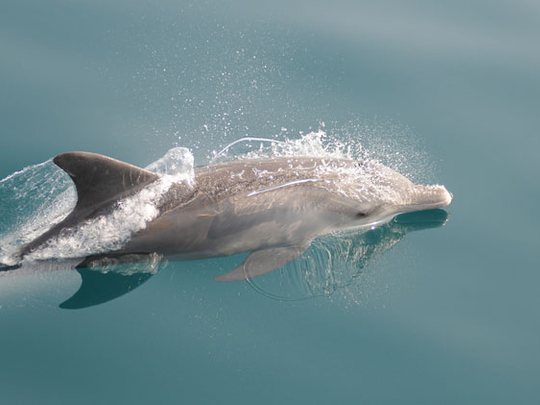
Abu Dhabi: The Environment Agency – Abu Dhabi (EAD) announced on Monday that its first vessel-based survey of dolphins in the coastal waters off the emirate of Abu Dhabi recorded two species of dolphins in the dozens.
The survey identified two different dolphin species in Abu Dhabi waters — the Indo-Pacific bottlenose dolphin (Tursiops aduncus) and the Indo-Pacific humpback dolphin (Sousa chinensis), an EAD press release said.
Seventy-seven bottlenose dolphins, of which 19 were calves, and 61 humpback dolphins, of which 10 were calves, were recorded. EAD also spotted two newborn calves, indicating that the dolphin calving season may occur in late spring/early summer in the emirate of Abu Dhabi.
The survey, as part of EAD’s new Dolphin Conservation Programme, aims to monitor the emirate’s dolphins, study their biology, habitats and geographical distribution, ultimately supporting the long-term conservation of the species.
Carried out by EAD’s marine species specialists, the survey included a capacity-building component for Emirati marine biologists, and involved volunteers from the Emirates Wildlife Society, in association with WWF, and the UAE Dolphin Project.
The 15-day survey was implemented using a custom-made 45-foot boat fitted with an observation platform, covering over 2,000 kilometres of Abu Dhabi’s coastal waters extending from the Sila Peninsula in the west to the border with Dubai in the east.
Ayesha Yousuf Al Beloushi, Director of Marine Biodiversity at EAD, said: “Dolphins are excellent indicators of the health and quality of our marine environment. The Dolphin Conservation Programme will help us better understand dolphin populations and their distribution, and identify key threats to help us develop effective conservation initiatives for these species.”
She said the survey was conducted in partnership with the Bottlenose Dolphin Research Institute in Spain, using the latest technologies to ensure that the conservation programme as a whole is being implemented within international standards.
A ‘photo-identification’ technology relying on unique markings on the dolphins’ dorsal fins was used to identify individual animals and effectively act as a tracking system, enabling the team to determine movement patterns and estimate the dolphins’ population size. Once again, EAD used drones, equipped with high definition cameras, to confirm the number of animals observed during sightings.
The survey results also revealed a distinct regional difference in species composition with the Indo-Pacific humpback dolphin being dominant around EAD’s Marawah Marine Biosphere Reserve, while bottlenose dolphins were dominant from Al Dhabbaiya to Ras Ghanadah and between Al Sila and Sir Bani Yas Island.
“The data collected from the survey will support us in further developing our conservation initiatives for our marine biodiversity, as well as helping us conserve the natural heritage of Abu Dhabi for future generations. The general public can also support this effort by reporting any sighting of dolphins or stranded dolphins to the Abu Dhabi Government Contact Centre by calling 800-555,” Ayesha said.












